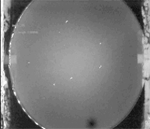Electric fields used to steer nematode worms like 'remote-controlled cars'
Researchers in the US have discovered an intriguing and fun dimension to the nervous system of nematode worms, enabling them to steer the tiny organisms ’like remote-controlled cars.’
Aravinthan Samuel and colleagues at the Harvard University studied Caenorhabditis elegans nematode worms as a model of sensorimotor integration - how sensory input is converted into movement by the nervous system. The 1mm-long worms were grown on plates covered in agar gel. When an electric field was passed across the gel, the worms moved towards the negative pole.
The effect itself is not new, but Samuel noticed that the worms followed a very straight trajectory, sticking almost exactly to the electric field lines. He decided to find out what else he could persuade the worms to do. ’I was very surprised that the behaviour was as robust as it is,’ he told Chemistry World. ’Nearly every worm is mesmerized by the field. Because I can rotate the field, I can actually steer the worms.’

C. elegans has a very simple nervous system of precisely 302 neurons (compared with 50,000 in Drosophila flies, and over 100 billion in humans) so it provides a very simplified model for study. ’We have the complete wiring diagram for the entire nervous system. So we should be able to completely comprehend sensorimotor integration from sensory neurons, to interneurons, to motor output in a way that would be unimaginable in more complex animals,’ team member Christopher Gabel told Chemistry World.
Watching neurons at work
Using a green fluorescent protein within the neurons, which glows in response to increased calcium concentrations, the team could visualise the specific neurons that were activated by changes in the electric field. ’We showed that certain sensory neurons respond to the strength and magnitude of the external electric field with proportional changes in intracellular calcium,’ said Samuel. An increase in calcium within a neuron is a good direct measure of its activity.
The researchers reported that they could entice the worms to perform specific types of manoeuvres, using electrical stimuli and by surgically or genetically altering these specific interneurons. ’From a behavioural perspective, the most exciting thing is that we can force the worm to make a specific choice, not just to reorient, but also about the type of turn it makes in order to reorient,’ Samuel concluded.
Victoria Gill
Enjoy this story? Spread the word using the ’tools’ menu on the left.
References
C Gabel et al, J. Neurosci., 2007, 27, 7586 (DOI: 10.1523/JNEUROSCI.0775-07.2007)






No comments yet